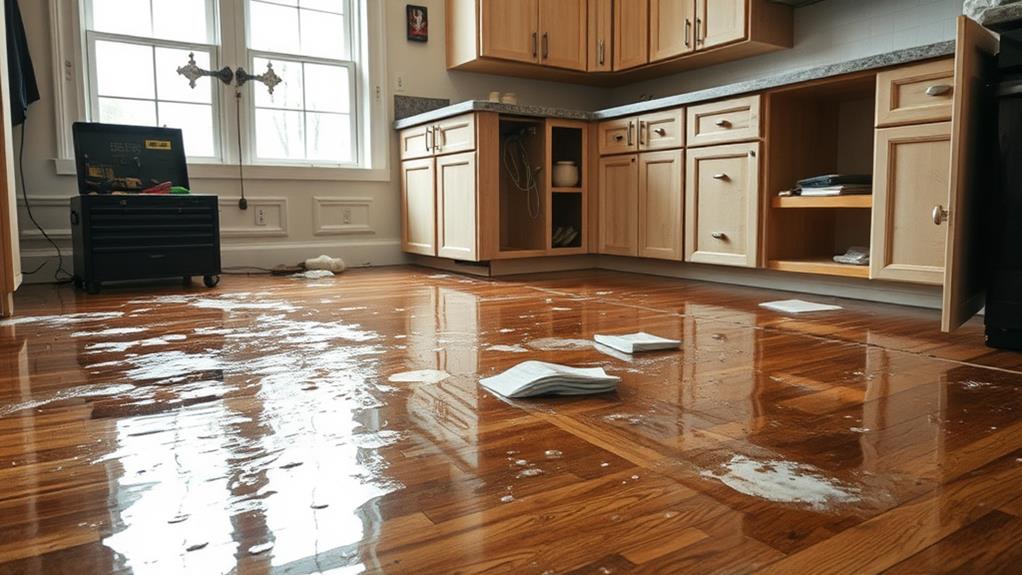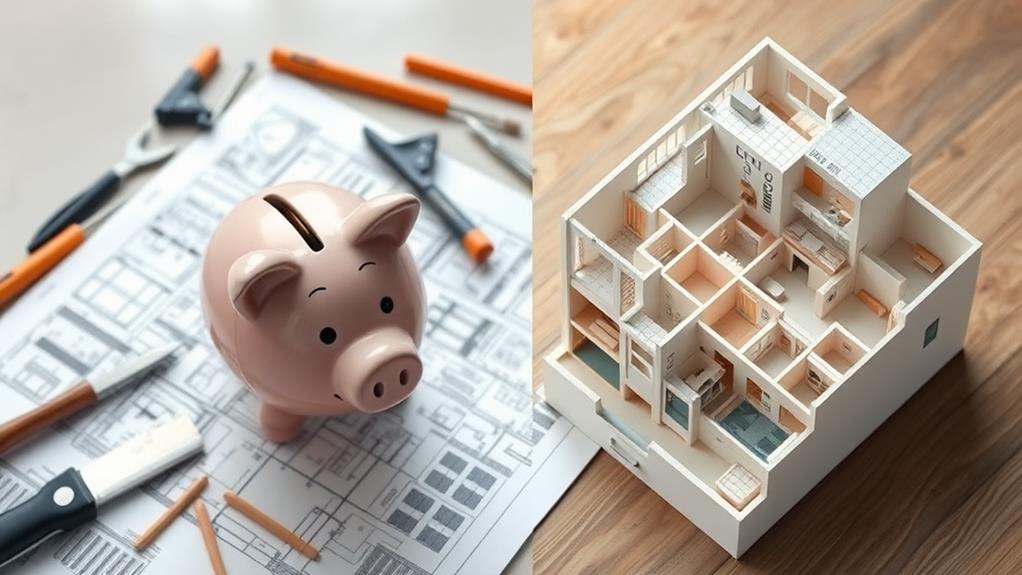A contingency fund is a crucial component of any home renovation budget. Typically set at 10-20% of the total project cost, this financial safety net covers unexpected expenses and unforeseen circumstances. It provides flexibility for addressing issues like structural problems, code upgrades, or material cost increases. Without a contingency, homeowners risk project delays, compromised quality, or even abandonment. A well-planned buffer ensures smoother decision-making, maintains project momentum, and preserves relationships with contractors. It transforms potential financial strain into peace of mind throughout the renovation process. Understanding the nuances of contingency planning can significantly impact the success and satisfaction of your home improvement project.
What Is a Contingency Fund?

A contingency fund is a financial safety net set aside within a home renovation budget to cover unexpected costs or unforeseen circumstances that may arise during the project. This reserve typically amounts to 10-20% of the total renovation budget, depending on the project's complexity and the condition of the property. The purpose of a contingency fund is to ensure that the renovation can proceed smoothly without delays or compromises due to financial constraints.
Contingency funds address various issues that may emerge during renovations, such as structural problems discovered after demolition, necessary upgrades to meet building codes, or increased material costs. They also provide flexibility to accommodate minor design changes or improvements that become apparent as the project progresses. By incorporating a contingency fund into the budget, homeowners can avoid the stress of scrambling for additional funds mid-project or having to scale back their renovation plans. This proactive approach helps maintain the project's timeline and quality while reducing the risk of financial strain. Ultimately, a well-planned contingency fund contributes to a more successful and satisfying home renovation experience.
Calculating Your Contingency Budget
Determining the appropriate contingency budget for your home renovation project requires careful consideration of several factors. Industry experts typically recommend setting aside 10-20% of the total project cost as a contingency fund. However, the exact percentage may vary depending on the scope and complexity of your renovation.
For newer homes or straightforward projects, a 10% contingency may suffice. Older homes or more complex renovations might warrant a 20% buffer or higher. To calculate your contingency budget, first estimate the total cost of your project, including materials, labor, permits, and any additional expenses. Then, multiply this figure by your chosen percentage.
Consider the following elements when determining your contingency percentage: the age and condition of your home, the extent of structural changes, the likelihood of encountering hidden issues, and your comfort level with risk. Additionally, factor in the current market conditions, as material and labor costs can fluctuate. It's crucial to be realistic and err on the side of caution when setting your contingency budget. Remember, any unused funds can always be allocated to upgrades or saved for future projects.
Common Unexpected Renovation Costs

Home renovation's hidden costs can catch even the most prepared homeowners off guard. These unexpected expenses often arise from unforeseen structural issues, outdated electrical systems, or plumbing problems that only become apparent once work begins. For instance, removing a wall may reveal mold, asbestos, or faulty wiring that requires immediate attention and additional funds to rectify.
Permit fees and inspections can also add to the budget, as local regulations may require multiple approvals throughout the renovation process. Labor costs can escalate if specialized tradespeople are needed for complex tasks or if the project timeline extends beyond initial estimates. Material price fluctuations or sudden shortages can impact expenses, especially for long-term renovations.
Upgrades to meet current building codes, such as improved insulation or updated HVAC systems, may be necessary but weren't factored into the original budget. Additionally, unforeseen design changes or last-minute additions requested by homeowners can significantly increase costs. Weather-related delays or damage can also lead to unexpected expenses, particularly for exterior renovations. By anticipating these potential hidden costs, homeowners can better prepare their contingency funds and avoid financial stress during their renovation projects.
Benefits of Having a Buffer
Given the prevalence of unexpected costs in home renovations, establishing a buffer in the form of a contingency fund offers numerous advantages. Primarily, it provides financial security and peace of mind throughout the renovation process. With a buffer in place, homeowners can confidently address unforeseen issues without derailing their project or compromising on quality.
A contingency fund allows for greater flexibility in decision-making. As the renovation progresses, opportunities for upgrades or improvements may arise. Having extra funds available enables homeowners to seize these opportunities, potentially enhancing the overall value and functionality of their property. Additionally, a buffer helps maintain project momentum by preventing delays caused by financial constraints. When unexpected costs occur, work can continue without interruption, saving time and potentially reducing overall expenses.
Furthermore, a contingency fund can help preserve relationships with contractors and suppliers. By having the means to promptly address additional costs or changes, homeowners can avoid conflicts and maintain a positive working environment. This can lead to better outcomes and a smoother renovation experience. Ultimately, a well-planned buffer ensures that the renovation stays on track, both financially and in terms of timeline, resulting in a more successful and satisfying project completion.
Risks of Skipping Contingency Planning

Failure to incorporate contingency planning into a home renovation budget can lead to significant risks and potential financial distress. Without a safety net, homeowners may face unexpected costs that can derail their project or force them to compromise on quality. Common unforeseen expenses include structural issues, plumbing or electrical problems, and material price fluctuations.
Skipping contingency planning can result in project delays or even abandonment if funds run out midway. This not only disrupts daily life but can also leave homes in an unfinished state, potentially decreasing property value. Additionally, homeowners may be forced to take on high-interest debt to complete the renovation, leading to long-term financial strain.
The absence of a contingency fund can also limit flexibility in decision-making during the renovation process. Opportunities for upgrades or design improvements may be missed due to budget constraints. Furthermore, cutting corners to stay within budget can lead to subpar workmanship or the use of inferior materials, potentially resulting in costly repairs or replacements in the future. Ultimately, neglecting contingency planning can transform what should be an exciting home improvement project into a stressful and financially burdensome experience.
When to Use Your Contingency
Prudence dictates that a contingency fund should be used judiciously during a home renovation project. This reserve is intended for unforeseen circumstances and genuine emergencies, not for upgrading finishes or expanding the project's scope.
Appropriate uses of contingency funds include addressing unexpected structural issues, such as discovering mold, asbestos, or faulty wiring behind walls. It may also cover costs associated with permit delays, weather-related setbacks, or sudden material price increases. If a critical appliance or system fails during renovation, the contingency can finance necessary replacements.
However, it's crucial to differentiate between essential uses and discretionary spending. Avoid tapping into the contingency for cosmetic upgrades or non-essential changes. If the renovation progresses smoothly without major issues, the contingency should remain untouched, potentially allowing for planned upgrades at the project's conclusion.
Regularly review the budget and contingency usage with your contractor. This ensures transparency and helps maintain financial discipline throughout the renovation. Remember, once the contingency is depleted, any additional unexpected costs may jeopardize the project's completion or require additional funding sources.
Replenishing Your Contingency Fund

After utilizing your contingency fund during a renovation project, it's important to consider replenishing it for future use. This proactive approach ensures you're prepared for unexpected expenses in subsequent home improvement projects or unforeseen maintenance issues.
To replenish your contingency fund, start by reassessing your monthly budget. Identify areas where you can reduce spending and allocate those savings towards rebuilding your fund. Consider setting up automatic transfers from your primary account to a dedicated savings account for your contingency fund.
If you've completed a major renovation, consider waiting before embarking on another large project. This pause allows you to focus on replenishing your contingency fund without the pressure of immediate expenses. Additionally, explore potential sources of extra income, such as selling unused items or taking on temporary work, to accelerate the fund's growth.
Regularly review and adjust your contingency fund target based on your home's current condition and any upcoming planned renovations. As your home ages or your renovation plans evolve, you may need to increase your contingency fund to adequately cover potential future expenses.
Industry Standards for Contingency Percentages
Several industry standards exist for determining appropriate contingency percentages in home renovation budgets. Generally, professionals recommend allocating between 10% and 20% of the total project cost for unforeseen expenses. However, this range can vary depending on the scope and complexity of the renovation.
For smaller, straightforward projects with minimal structural changes, a 10% contingency may suffice. Larger, more complex renovations involving older homes or significant structural modifications typically warrant a higher percentage, often closer to 20%.
Some experts suggest using a sliding scale based on project size: 20% for projects under $100,000, 15% for those between $100,000 and $500,000, and 10% for renovations exceeding $500,000.
It's important to note that these percentages are guidelines rather than strict rules. Factors such as the home's age, condition, and local market conditions can influence the ideal contingency amount. Additionally, homeowners should consider their risk tolerance and financial flexibility when determining their contingency fund. Consulting with experienced contractors or renovation specialists can provide valuable insights into appropriate contingency percentages for specific projects, ensuring a more accurate and realistic budget.
Adjusting Contingency for Project Complexity

Project complexity plays a crucial role in determining the appropriate contingency percentage for home renovations. As projects become more intricate, the likelihood of unforeseen issues increases, necessitating a larger contingency fund. Simple projects, such as painting or minor repairs, may require only a 5-10% contingency, while complex structural changes or whole-house renovations might warrant 20-30% or more.
Factors influencing project complexity include the age of the home, scope of work, and required permits. Older homes often harbor hidden problems like outdated wiring or asbestos, which can significantly impact costs. Extensive renovations involving multiple rooms or systems increase the potential for unexpected challenges.
Additionally, projects requiring numerous permits or inspections may face delays or additional requirements, further justifying a higher contingency percentage.
Homeowners should consult with experienced contractors to assess their project's complexity accurately. Professionals can identify potential risk areas and recommend appropriate contingency levels based on similar past projects. By adjusting the contingency fund to match the project's complexity, homeowners can better prepare for unexpected costs and ensure their renovation stays on track financially.
Frequently Asked Questions
Can I Use My Contingency Fund for Upgrades or Non-Essential Improvements?
Generally, it's not advisable to use your contingency fund for upgrades or non-essential improvements. This fund is primarily intended for unexpected issues or emergencies that arise during the project. Using it for upgrades may leave you financially vulnerable to unforeseen problems.
How Do I Convince My Partner or Spouse About the Need for a Contingency Fund?
Did you know 80% of home renovations exceed budget? To convince your partner about a contingency fund, highlight potential unforeseen issues, show real-life examples, and emphasize how it protects your investment and reduces stress during the renovation process.
Are Contingency Funds Tax-Deductible for Home Renovation Projects?
Contingency funds for home renovation projects are generally not tax-deductible. However, specific renovation expenses may be deductible in certain circumstances, such as home office improvements or energy-efficient upgrades. Consult a tax professional for personalized advice regarding your situation.
Should I Disclose My Contingency Budget to Contractors During the Bidding Process?
Like a poker player holding their cards close, it's generally advisable not to disclose your contingency budget to contractors during bidding. Keeping this information private can help ensure you receive accurate, competitive bids without inflated costs.
Can I Invest My Contingency Fund While Waiting to Use It?
Investing your contingency fund is possible, but consider low-risk, highly liquid options to ensure quick access when needed. Short-term savings accounts or money market funds may be suitable. Always prioritize accessibility over potential returns for contingency funds.
Conclusion
In an ironic twist, the most carefully planned renovations often unravel due to unforeseen circumstances. A robust contingency fund stands as the unsung hero, silently absorbing the shocks of unexpected costs and delays. While some may view it as an unnecessary expense, its absence can transform a dream project into a financial nightmare. Prudent homeowners recognize that the true measure of renovation success lies not in avoiding surprises, but in being prepared for them.

